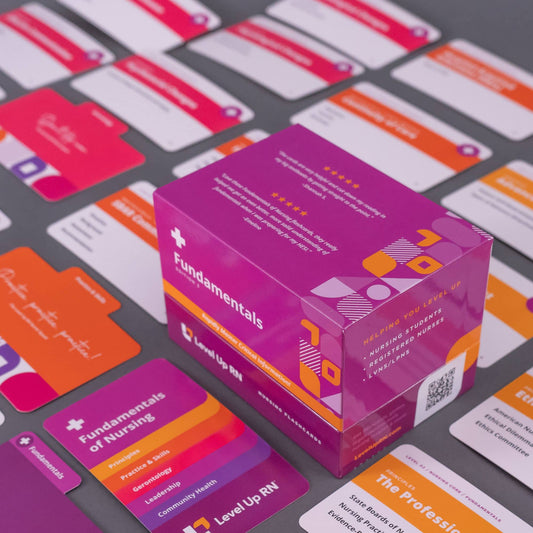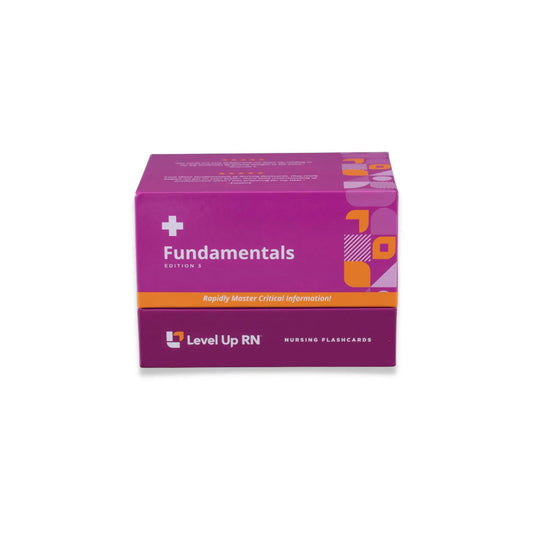Fundamentals of Nursing - Flashcards
This article covers urine characteristics, urinary specimen collection, urinary incontinence, and urinary tract infections (UTIs). You can follow along with our Fundamentals of Nursing flashcards, which are intended to help RN and PN nursing students study for nursing school exams, including the ATI, HESI, and NCLEX.
Urine characteristics
The following are the expected characteristics of urine — its normal values and limits.
Urine output
Daily urine output should equal daily fluid intake. The expected output ranges from 0.5 – 1.5 mL/kg/hr or approximately 1,500 mL/day.
Alert provider for urine output less than 30 mL/hr. This could indicate that the patient has severe oliguria (not a lot of urine).
Urine color
The color of normal urine ranges from light yellow (straw-colored) to amber.
Urine appearance
Urine should be clear (transparent, not cloudy). It should not be malodorous, which could indicate a health issue.
Urine should not contain: glucose, ketones (an indicator of diabetic ketoacidosis or "DKA"), blood, protein, bilirubin, nitrates, or leukocyte esterase (a screening test used to detect white blood cells in the urine).
Urine specific gravity
Specific gravity is a measurement used in urinalysis and describes the concentration level of the urine. The normal range is 1.005 to 1.030.
Urine specific gravity less than 1.010 indicates dilute urine. The causes of dilute urine include kidney dysfunction, diabetes insipidus, and excess fluid intake.
 DiLute = Low urine specific gravity.
DiLute = Low urine specific gravity.
Urine specific gravity more than 1.025 indicates concentrated urine. The causes of concentrated urine include dehydration (e.g., diarrhea, emesis (vomiting), sweating), SIADH, and UTI.
You can learn more about the normal value ranges for urine, including output, specific gravity and more, with our Lab Values Study Guide & Flashcard Index, a list of lab values covered in depth in our Lab Values Flashcards for nursing students.
Urine sample collection
Urine specimens may be collected in a number of ways, often by the patient. These include routine urinalysis, clean catch, sterile specimens, and 24-hour urine specimen collection.
Routine urinalysis
A routine urinalysis is collected during normal voiding. Note that when collecting a pure urine sample, avoid contamination with feces.
If the sample cannot be analyzed within 1 hour, refrigerate it.
Clean catch urine specimen
In a clean catch urine specimen, the patient collects the sample while they are urinating. Generally, clean the penis or vulva with sterile moist wipes. Waste the initial amount into the toilet, then position the sterile container into the stream to collect the urine. Only 15 – 30 mL is needed for analysis.
There are different teachings for those with a penis and those with a vulva.
Clean catch specimen collection for a male (penis)
If a patient has a penis and is uncircumcised, teach them to retract the foreskin and then clean around the urethral meatus (the opening of the urethra) in concentric circles. They should replace the foreskin after they are done urinating.
Clean catch specimen collection for a female (vulva)
For a patient with a vulva, they should separate the labia so that the urethral opening is exposed and clean the area from front to back using sterile wipes (usually Castile soap wipes). This is to clean away any kind of grime or dead skin cells from the area to allow for the collection of a cleaner sample. When urinating, they should hold the labia apart.
Note that patients should always begin urinating into the toilet, stop, then urinate into the collection cup, stop, and then finish urinating into the toilet. This is called midstream clean catch.
Sterile urine specimen
Sometimes a sterile environment is required, and that can mean catheterizing the patient or collecting from a special sampling port on an indwelling catheter. Never collect a sample from a drainage bag!
24-hour urine collection
24-hour urine collection is when the patient collects their urine for 24 hours in a designated container.
The most important patient teaching here is to discard the first void of the day (which is usually more concentrated and could adversely affect the lab results), then collect all of the urine voided in the next 24 hours.
Patients should be taught to keep the container refrigerated between sample collections.
Urinary incontinence
Urinary incontinence is the loss of bladder control, leading to urine leakage. There are diverse reasons for urinary incontinence.
Stress incontinence
Stress incontinence is when there is a small urine leak as a result of increased intra-abdominal pressure. For example, when sneezing, coughing, or laughing, the pressure on the abdomen increases, which then puts pressure on the bladder, causing a small urine leak. The underlying cause of this condition is a weakened pelvic floor.
Risk factors for urinary stress incontinence
The risk factors for urinary stress incontinence include patients who have had multiple pelvic surgeries or patients who have had multiple pregnancies or deliveries of infants, both of which will weaken the pelvic floor muscles.
Obesity and menopause are further risk factors.
Urge incontinence
Urge incontinence is the inability to make it to the bathroom in time when feeling the urge to urinate. This is due to an overactive detrusor muscle (the smooth muscle in the bladder).
Risk factors for urinary urge incontinence
The risk factors for urinary stress incontinence include neurologic disorders (e.g., stroke) and bladder irritation.
Treatment for urinary incontinence
Treatments for urinary incontinence include behavioral and pharmacological therapies, as well as the use of mechanical devices.
Behavioral therapy
These therapies include creating a toileting schedule or constipation management — regimens for creating consistent practices around voiding. Other behavioral therapies include Kegel exercises (training exercise to strengthen the pelvic floor), weight loss, and a decrease in caffeine and/or alcohol intake.
Pharmacological therapy
Medications may be prescribed to combat urinary incontinence, including anticholinergics (e.g., oxybutynin) and topical estrogen for women.
Mechanical devices
Mechanical devices such as cones or pessaries — devices that lift the bladder or apply compression to the urethra and can be inserted to maintain pressure and decrease the risk of urine leaking — may help treat urinary incontinence.
Urinary tract infection
A urinary tract infection is an infection in any part of the urinary tract. The most common type of UTI is a bladder infection (e.g., cystitis, an inflammation of the bladder).
Dealing with urinary tract infections is common in nursing practice, and it’s a topic that appears repeatedly in nursing school. The patient teaching for UTIs is, therefore, very important.
Risk factors for UTIs
People who have a vulva are most at risk for a UTI. The urethra is much shorter in a vulva than a penis, and there is close proximity of the urethral meatus to the anus. The penis, with its longer urethra, means it is harder (but not impossible) for bacteria to enter into the urinary stream.
Other risk factors for UTIs include Foley catheters (the most common type of indwelling urinary catheter), uncircumcised males, menopause, frequent sexual intercourse, and constipation.
Signs and symptoms for UTIs
The signs and symptoms for UTIs include abdominal pain, dysuria (painful urination), urinary frequency and urgency, nausea/vomiting, cloudy urine, a burning sensation when urinating, foul-smelling urine, and confusion (in older adults, who may not present classical symptoms).
Diagnosing UTIs
A diagnosis of UTI will be if the urinalysis results are positive for bacteria, WBCs, leukocyte esterase, nitrates, or blood.
This information and more may also be found in the Renal System section of our Medical-Surgical Nursing Flashcards (Vol. 3).
Prevention of urinary tract infections
The prevention of urinary tract infections — and the patient teaching of preventative measures — is another important part of nursing school.
- Females, after urinating, wipe front to back — this is to prevent bringing fecal bacteria up to the urethra; also:
- Choose cotton underwear rather than artificial fabric; natural fibers are better at wicking moisture away and not trapping moisture, which bacteria love
- Avoid: bubble baths; sitting in wet bathing suits; tight clothing
- Uncircumcised males: clean under the foreskin after urinating
- Empty the bladder regularly
- Avoid constipation
- Urinate after vaginal penetrative intercourse
- Increase fluid intake: aim to drink 3 liters of fluid per day
- Cranberry juice: drinking cranberry juice can also help to decrease UTI symptoms


